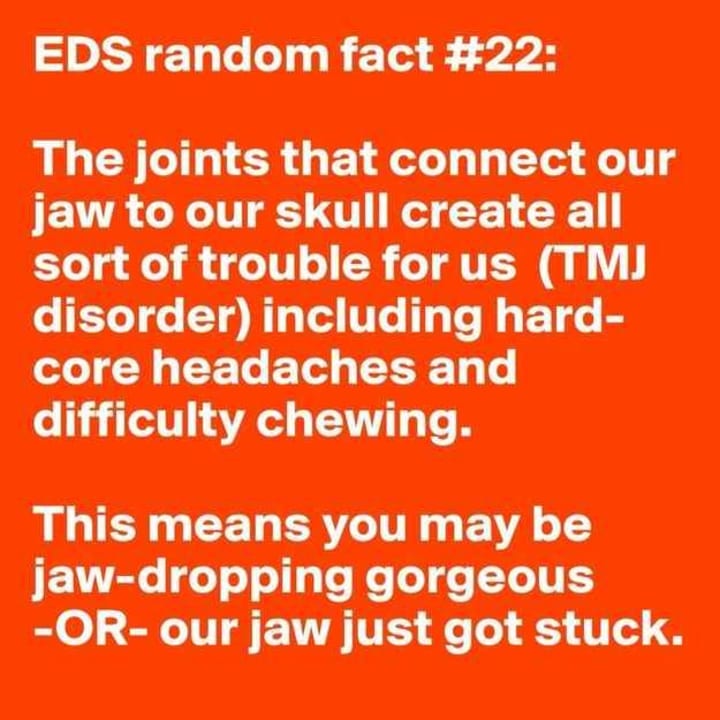Hypermobile Ehlers-Danlos Syndrome
A personal guide without the scientific garble.
One thing I'd like to make clear first is that Ehlers-Danlos Syndrome, all types, affects everyone differently. For some it may not affect them at all, for others it impacts every single aspect of their life to the extent that feeding tubes, wheelchairs, and long hospital stays has much become the norm to them and their families.
I'm one of the fortunate ones where only a walking stick is needed to help me venture out into the big, wide world.
So, what is Hypermobile Ehlers-Danlos Syndrome (HEDS)?
HEDS is a rare connective tissue disorder caused by a defect in our collagen, and as a rule can be inherited by either parent. Luckily for us HEDS-ers, however, it's the least severe form, unlike Vascular EDS. This doesn't mean that we don't deal with severe complications; severe issues can occur no matter how much treatment we receive and for the most part is always a guessing game as to what will affect us next.
The most recent for myself is the dislocation of my ribs which gave me a case of costochondritis i.e. inflamed rib cartilage - yeah, I know what you're thinking, "ouch" right? But in all honesty, I did that in my sleep after the swelling in my chest and stomach disappeared. For all of ten hours. Whoopee!
Better yet, trips to the hospital for things like this are pretty useless (in my experience, that is); I'm lucky if I can leave A&E without having doctors think I'm a hypochondriac due to the amount of things I've had to learn about my body over the last few years.
Fun fact: Generally more women than men live with the disease.
The Sciencey Stuff
Ehlers-Danlos Syndrome has thirteen subtypes.
Each subtype has its own individual criteria to better suit clinical diagnosis. The biggest aid to doing so is the patient's physical symptoms being matched to other minor and major criteria to identify which subtype the patient is most suited to.
For a definitive diagnosis to occur, there must be confirmation from genetic testing to identify which gene is affected. However, this does not yet apply to the hypermobile subtype; yay, us! *eye roll*
(Buuuut, recent evidence shows that a small percentage of people with this condition have a change in the TNXB gene; maybe there's luck for us after all!)
Sadly before a patient reaches this point, the majority of sufferers tend to be misdiagnosed with other musculoskeletal disorders, chronic fatigue syndrome, and even hypochondriasis.
EDS Type Chart

* Inheritance Pattern: AD = autosomal dominant; AR = autosomal recessive
How do you get diagnosed with HEDS then?
Easy. Well, not really, you'll see why now in a minute.
To be diagnosed with HEDS heavily relies on the physical symptoms of your body and a really knowledgeable doctor. Luckily for a friend of mine she was diagnosed at a specialist Ehlers-Danlos clinic in London. I however was diagnosed by a knee-specialist at the Aberdeen Royal Infirmary—thanks, Doc, by the way!
One of the easiest parts of diagnosis is what I like to call the Beighton Strip Tease, otherwise known as the Beighton Hypermobility Score. This is based on a series of movements, such as getting your thumb to touch the inside of your arm, and is marked out of nine. My score: 7/9.
The second part of diagnosis is based on a series of different features. The patient must show manifestations of at least two of these features and then a certain majority within them. If it sounds just as confusing as it is for me to write it, I sincerely apologise, and to help you understand please have a look at the link to the rare diseases website which goes into much more detail about these 'features'.
Please see: https://rarediseases.info.nih.gov/diseases/2081/hypermobile-ehlers-danlos-syndrome
The signs and symptoms of what is sometimes a living hell.
Personally, I like to look at my Ehlers-Danlos Syndrome as more of an "umbrella term," and those of you with the condition will understand that EDS is the tip of the genetic lottery iceberg. It sounds crazy, but as time goes on, so does your list of ailments. Here are just some of the possible symptoms:
- Joint hypermobility
- Dislocations and subluxations
- Chronic pain
- Osteo- and rheumatoid arthritis
- Fragile and/or soft velvety skin
- Postural Orthostatic Tachycardia Syndrome (POTS)
- Gastrointestinal dysfunction
For more information about symptoms please go to: https://www.ehlers-danlos.com/what-is-eds/
#HangInThereDarling

Please, if you like a bit of humour in life, Google "EDS Random Fact" in the image search bar!
So, how do you survive and stuff?
It isn't the end of the world as we know it. Trust me, been there, done that and got the postcard.
Living with HEDS is all about maintenance. Literally, some days I can't help but feel like a new species of human with all the tape and metal I have to wear just to go and do the simplest of things outside of my home.
Having the right medication is key to getting in control of things and it can take some time finding out which medication works best for you. Some may find it straight away, others may need years to find the 'one' but even then, you may find yourself needing to up dosages or try other alternatives.
Physiotherapy and low-impact sports such as swimming and yoga are a fantastic way to maintain your body muscle, lower risk of future injuries and help to reduce pain. But please bear in mind that it is always best to seek medical advice before taking part in anything physical so that you are fully aware of the implications it may have on your body, or to see if there is something more suitable to you at the time!
Alternative therapy such as cognitive behavioural therapy (CBT) and emotional freedom technique (EFT) have proven to be quite useful when dealing and coming to terms with an EDS diagnosis and learning to cope with everyday symptoms and challenges. Other therapies that can also be used are verbal, art, music and drama.
Diet is another crucial aspect to maintain your condition. This is where I dictate eating a balanced diet with your 5-a-day. Obtaining the right amount of nutrition everyday is more important than you realise and it's not just about losing or gaining weight (as sometimes the medication we're on can make that so difficult to do). Instead, it's about making sure our body isn't lacking any of the important vitamins, minerals, and energy we need to keep our bodies in as healthy a state as possible. Lets be honest, they're going to be doing a lot more work than the average EDS-free being. Vitamin D is one of the most popular vitamins we lack, so please speak to your local GP or pharmacist to point you in the right direction.
Keep in contact with your doctor by attending regular appointments so that they can keep track of medication(s), symptoms, progress etc. This is the best thing that you can do, by making sure all your medical information is up to date! It helps to make any future aid and diagnosis easier on both you and your doctor.
Lastly, always keep a positive attitude, there are so many support groups out there to reach out to for anything and everything, even if it's just to rant when things get you down. It also helps you to realise that you are not alone and there are others out there going through exactly the same thing, especially if there is no one else in your family with the same or similar conditions. Personal recommendations are:
- Inspire Online Community
- Ehlers Danlos Syndrome type 3 (Facebook)
- Little Zebras ; Life With Ehlers Danlos Type 3-"Hyper-mobility Syndrome" (Facebook/ For parents of children under 12 with HEDS)
Resources:
http://www.nhs.uk/Conditions/ehlers-danlos-syndrome/Pages/Introduction.aspx#inheritance
https://www.ehlers-danlos.org/about-eds/types-of-eds/hypermobility-ehlers-danlos-syndrome/
https://www.ehlers-danlos.com/what-is-eds/
http://onlinelibrary.wiley.com/doi/10.1002/ajmg.c.v175.1/issuetoc
"Ehlers–Danlos Syndrome". Mayo Clinic. Retrieved 25 May 2012.
Brockway, Laura (April 2016). "Gastrointestinal manifestations of Ehlers–Danlos syndrome (hypermobility type)". Ehlers–Danlos Support UK.
About the Creator
Lana Sousa
I'm one of those cliché millennials still trying to get their life together, replacing good choices with coffee and cigarettes.
Warrior of Invisible Illness, Defender of the Unknown and Writer of History, Languages, Ethics and Spirituality.






Comments
There are no comments for this story
Be the first to respond and start the conversation.